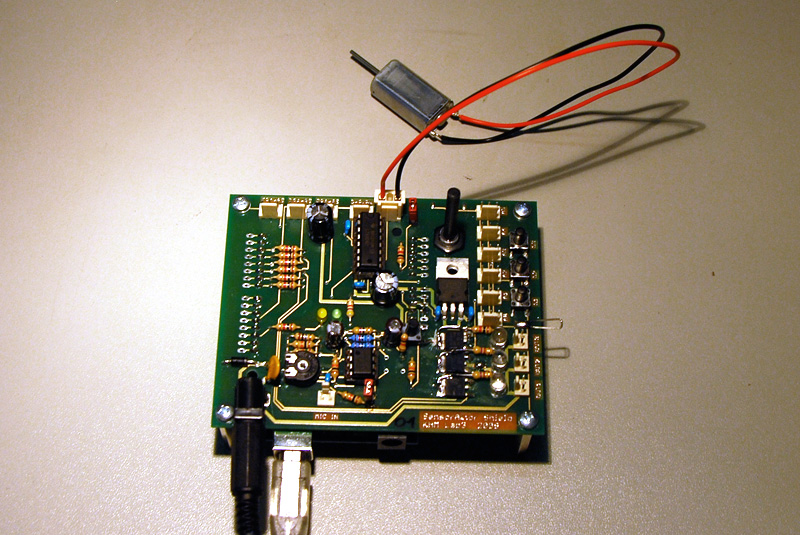Simple DC motor controller
Basic example of a simple DC motor controller using the built-in L293 chip of the SensorAktor-Shield.
/* simple motor controller
*
* control speed of a motor
*
* SensorAktor Workshop
* Lab3 2008
* Kunsthochschule fuer Medien Koeln
* Academy of Media Arts Cologne
* http://interface.khm.de
* pin mapping SensorAktor Shield
* import SensorAktor.h to get already defined mapping
*
* analog inputs: analog0 = pin0, analog1 = pin1, analog2 = pin2,
* analog3 = pin3, analog4 = pin4, analog5 = pin5
* built-in poti: poti = pin5
* amplified input: mic = pin0
* switches: switch1 = pin1, switch2 = pin2, switch3 = pin3
* leds: led1 = pin3, led2 = pin5, led3 = pin6
* power outs: out1 = pin3, out2 = pin5, out3 = pin6
* motor outs: motor1_1 = pin8, motor1_2 = pin13, motor2_1 = pin11, motor2_2 = pin12
* motor pwms: pwmMotor1 = pin10, pwmMotor2 = pin9
* servo outs: servo1 = pin2, servo2 = pin4, servo3 = pin7
*/
// import sensor aktor library for pin mapping
#include <SensorAktor.h>
// import motor library
#include <MotorL293.h>
// create instance for motor
MotorL293 myMotor;
// poti value
int potiValue = 0;
// this block is executed one time when programm starts
void setup(){
// attach pins to motor (motor pin1, motor pin2, pwm pin motor)
myMotor.attach(motor1_1, motor1_2, pwmMotor1);
// set direction (0=left, 1=right)
myMotor.setDirection(0);
}
// this block is executed in a loop after setup is called one time
void loop(){
// read poti (value between 0 and 1023)
potiValue = analogRead(poti);
// scale poti value to use it with setPower (value between 0 and 254)
potiValue = map(potiValue, 0 , 1023, 0, 254);
// set speed of motor using poti value (value between 0 and 254)
myMotor.setPower(potiValue);
}
We developed a simple library to control a DC motor using the L293 chip. Include it in the header of your code and define a variable for the motor.
// import motor library #include <MotorL293.h> // create instance for motor MotorL293 myMotor;
Then attach the pins to the motor and set the direction.
void setup(){
// attach pins to motor (motor pin1, motor pin2, pwm pin motor)
myMotor.attach(motor2_1, motor2_2, pwmMotor2);
// set direction (0=left, 1=right)
myMotor.setDirection(0);
}
To drive the motor use the setPower() function.
// set speed of motor using poti value (value between 0 and 254) myMotor.setPower(potiValue);
You can have a view at the “MotorL293.cpp” file to get an idea, how the motor is controlled. We use the PWM to set the power of the motor. To get a better result the PWM frequency is increased by setting its prescaler to 1.
// Timer 1 prescaler to 1 cbi(TCCR1B, CS12); cbi(TCCR1B, CS11); sbi(TCCR1B, CS10);
The direction of the motor is set by switching motor pin1 and motor pin2 polar.
// set direction
void MotorL293::setDirection(int direction){
// turn left
if(direction == 0){
digitalWrite(motorPin1,HIGH);
digitalWrite(motorPin2,LOW);
}else{
digitalWrite(motorPin1,LOW);
digitalWrite(motorPin2,HIGH);
}
}
Files needed
Since Arduino 0015 there are some problems with the old “SensorAktor.h” file.
Use this one instead.


